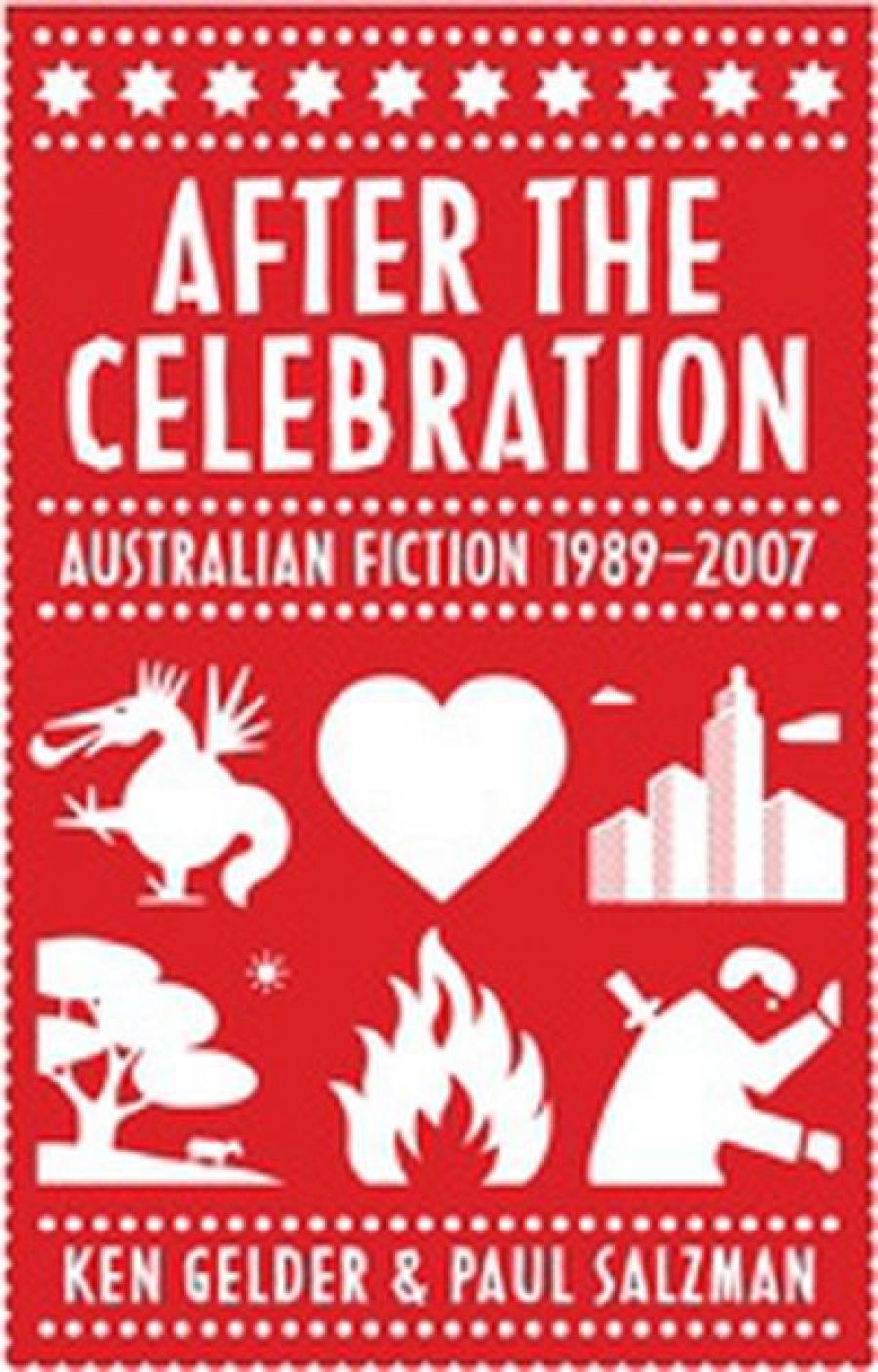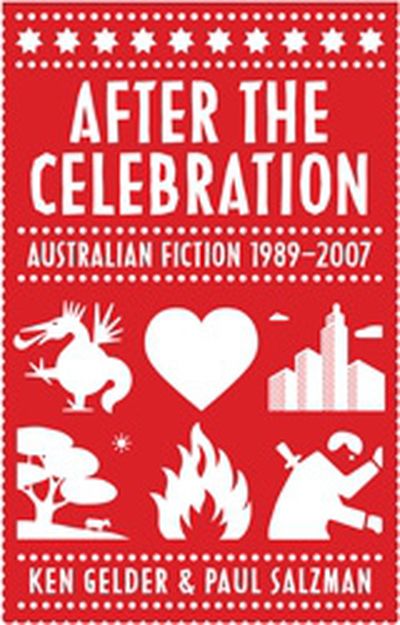
- Free Article: No
- Contents Category: Literary Studies
- Review Article: Yes
- Article Title: Sour emanations
- Online Only: No
- Custom Highlight Text:
Twenty years after the publication of their ‘inclusive Australian literary history’, The New Diversity: Australian Fiction 1970–1988, Ken Gelder and Paul Salzman have returned with a ‘sequel’, After the Celebration: Australian Fiction 1989–2007. One leaden title succeeds another, although the tone of the second book is angrier. More of that later. As the authors note in their preface, The New Diversity was published by McPhee Gribble, an independent outfit that would largely be subsumed by Penguin in 1989, the year in which that book appeared. This observation prepares for the consistently impressive aspect of After the Celebration: its detailed, incisive, intelligently informed account of the changes in the circumstances of publishing, and especially fiction publishing, in Australia during the last two decades. One might take counsels of hope or despair from their analysis (particularly if one were a novelist), but still be grateful for it.
- Book 1 Title: After the Celebration
- Book 1 Subtitle: Australian Fiction 1989–2007
- Book 1 Biblio: MUP, $29.99 pb, 292 pp
- Book 1 Cover Small (400 x 600):

- Book 1 Cover (800 x 1200):

There are six chapters in the book: ‘Belonging’, ‘Genre Fiction’ and ‘Literary Politics’ from Gelder; ‘Recolonising: Historical Fiction and the History Wars’, ‘Literary Fiction’ and ‘Is There a Women’s Chapter?’ from Salzman. These headings promise a judicious measuring of the work of the 125 Australian novelists who are discussed. The fatuous but now seemingly immovable term ‘literary fiction’ (its coinage the fault of publishers and not these authors) is clarified by comparison with Gelder’s illuminating discussion of ‘genre fiction’. Reflecting on why an earlier decision to have no separate chapter on women’s fiction was changed, Salzman presents a spryly titled section which persuasively justifies these second thoughts. Such choices are the privilege and the risk accepted by literary historians.
After the Celebration is everywhere attuned to issues of Aboriginal rights and land conservation, to ‘belonging’ and authenticity. Gelder floats, and justifies, such categories as ‘moral apocalypse fiction’ and ‘eco-genealogical fiction’ in his first chapter. Some perceptive close reading follows of the novels of Andrew McGahan, Tim Winton, Murray Bail and David Foster, among others. But by this early stage one is forced to ask a fundamental question about the organisation of the book. If ‘the novel is itself a genre … alongside poetry and drama’, then the question ‘what genre is genre?’ might be posed. More simply, why did the authors not employ the plain and useful term ‘sub-genre’ for the different kinds of novels that they examine? Their list is an enticing one, but sub-genres are what it lists: ‘eco-genealogical novels, various colonial historical sagas [set in, rather than written in that period], European-Australian novels [European in ‘sensibility’ and ‘feel’, that is], postmodern novels, moral realist novels, middlebrow women’s fiction [but not men’s], grunge novels, the ‘rural apocalypse’ novel [quoting themselves], the women’s erotic novel, the Asian-Australian novel, Australian chick lit and so on’.
That these signposts are mainly followed, often in enlightening ways, is to the authors’ credit. Yet the authoritative ticking of boxes and the semblance of inclusiveness are misleading. After the Celebration is so slapdash in its execution that a wider confrontation with its arguments is not easy to stage. First, to narrow the focus. Both authors, although mainly Salzman, endlessly deploy the querulous modifier ‘rather’. In every case it should have been ditched. The effect is of timidity, of minds that lack conviction in their judgements, even if at all times they seem bent on making them. Next to remark are the smuggled quotations, mostly unsourced, but intended quietly to coerce our agreement about such disparate matters as ‘high aesthetic values’ (David Malouf the culprit) or ‘bad multicultural [novels]’ (whichever they are).
More insidious is the persistent use of such terms of praise for their favourite authors as ‘much-acclaimed’, ‘highly-respected’. By whom, and why? Do the authors believe that public, or is it critical, endorsement is a sign of aesthetic worth? After all, at times they profess themselves troubled by the supposedly monolithic white middle-class (but they do not say mainly female) readership that some of their authors seek. Favourites are played ceaselessly. If Elizabeth Jolley’s fiction is ‘redemptive’, good. If Thomas Keneally’s is reckoned likewise, perhaps not. There is a steadily narrowing focus of approval throughout the book. One gets the feeling (and The New Diversity produced a similar impression) that the authors do not like much of the literature that they survey.
Certainly, they do not like the political times in which much of it was produced. One of the most indexed (and demonised) figures in the book – with twenty separate references – is ‘Howard, John’. The ex-prime minister is seen as actively inimical to literary culture in Australia. The most used curse word in After the Celebration (always pejorative, never analytical) is ‘conservative’ or – in the case of Leonie Kramer – ‘deeply conservative’. Those so branded include critics and reviewers, principally, besides some writers and politicians. It is a label about which Gelder and Salzman admit neither qualification nor discussion. Thus they caricature and traduce people of complicated and shifting allegiances, let alone good will towards Australian culture. The book has one egregious instance of this disparagement.
In August 2007 (‘the last year of John Howard’s tenure as prime minister’, had we been likely to forget), ‘a highly selective “round table” was convened in Canberra’ to discuss, most importantly, the perceived decline in the teaching of Australian literature at secondary and tertiary levels. Behind (or under, or on top of) the round table, Gelder and Salzman reckon, was the malign spirit of ‘conservative nationalism’. I didn’t see either of them there. I did see Bob Carr and Bob Sessions among dozens of independent supporters of Australian literature. Not much conservative co-option or line-toeing went on that day. Rather, there was a stringent, if brief, investigation into practical ways to teach, publish and disseminate books by local writers. The chair – ‘conservative political journalist’ Imre Salusinszky – is, more than that, a lover of literature and more than the author of a ‘little book’ on Gerald Murnane (another of Gelder’s cheap shots). Finally, Julie Bishop’s speech of the night before, as education minister, is flagrantly misrepresented. No mention is made of the ‘[universally] acclaimed’ initiative to fund a new Chair of Australian Literature, since taken up at the University of Western Australia by Philip Mead.
But back to After the Celebration. A careful edit would have dealt with the problem of repetition, admittedly something likely in a book constructed in this way. However, no excuse can be made for the repetition on page ninety-eight of Robert Dixon’s extended comparison of Tim Winton and David Malouf that was first cited on page thirty. Dixon, by the way, is one of the few named and approved critics or reviewers in the Australian literary firmament. His ears might be red. Everywhere, questions are begged. ‘Gothic’ is used with abandon, and with no precision. For instance, ‘Gothic has long been associated with rural Australia’. So has drought. ‘David Malouf’s short stories are exemplary instances of high literary culture’. And what is that, and does Australia have it? Will Helen Garner grimace when she learns that her writing is ‘always attuned to the luminous nuances of the details of everyday life’? Salzman speaks, tantalisingly, of ‘a genre that we might call moral realism’. Well we might, but what is it?
On we could go, from the intemperate attack on Thea Astley’s novel Drylands (1999) – ‘sheer intolerance for anything outside the limited range of its own metropolitan consciousness’ (this about a pre-eminently regional writer, and from a couple of Melbourne academics) – to Gelder’s desperate attempts to deal himself into the game. A critical review of a John Birmingham novel leads to his appearance in the next one as the ‘humourless’ Untersturmführer Gelder. On the other hand, Matthew Reilly responds to an encouraging Gelder review by promising to do better henceforth.
There is a sour emanation from this book, in its seeking of targets for disdain, its hedged approvals, its castigation of writers for slips from political grace, its contemptuous lumping together of most of those in the ‘literary establishment’, compared with the uncritical championing of the few who belong in Gelder and Salzman’s playground, if not ‘gangland’. Trying to put After the Celebration in a literary-historical perspective is to find something truly surprising. It is nothing less than the politically correct recrudescence of the adversarial Leavisite judgmentalism that once flourished at the universities of Melbourne and La Trobe, respective homes to Ken Gelder and Paul Salzman.


Comments powered by CComment